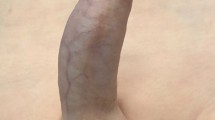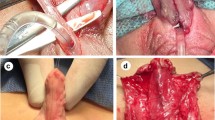Abstract
Purpose
The purpose of the study was to determine if there were differences in the complication rates between foreskin reconstruction (FR) and circumcision (CIRC) in distal hypospadias repairs. The primary outcomes were urethrocutaneous fistula (UF) and dehiscence.
Methods
The data of distal hypospadias operated between 2005 and 2013 were retrospectively reviewed. The inclusion criteria were any distal hypospadias repair that required an urethroplasty. The exclusion criteria were follow-up <1 year, redo procedures, chordee greater than 20°, and incomplete data. Univariate and multivariate analysis was performed on the results.
Results
213 patients were included (95 FR and 118 CIRC). The 2 groups were comparable for age at surgery 19.32 months in FR and 14.25 months in CIRC. Mathieu repair was more common in FR (47/95–49.47%) than in CIRC (45/118–38.14%). The total subsequent procedures required were 23 in FR and 57 in CIRC. The incidence of UF was 6.3% (6/95) in FR and 27.1% (32/118) in CIRC (p < 0.001, OR 5.52, 95% CI 2.2–13.9). Complete dehiscence rates were 3.16% (3/95) FR vs 11.02% (13/118) for CIRC (p = 0.037, OR 3.8, 95% CI 1.05–13.74). The incidence of patients requiring reoperation was 18.9% (18/95) in FR versus 45.8% (54/118) in CIRC (p < 0.001, OR 3.61, 95% CI 1.93–6.76).
Conclusions
Foreskin Reconstruction conferred a significantly lower rate of complications, particularly the UF rate, dehiscence rate, and number of patients that required reoperation. Our rate of complications in the CIRC group is much higher than other published data.








Similar content being viewed by others
References
Na AF, Tanny SPT, Hutson JM (2015) Circumcision: is it worth it for 21st-century Australian boys? J Paed Child Health 51(6):580–583
Snodgrass W, Dajusta D, Villanueva C, Bush N (2013) Foreskin reconstruction does not increase urethroplasty or skin complications after distal TIP hypospadias repair. J Pediatr Urol 9:401–408
ElGanainy EO, Hameed DA, Abdelsalam YM, Abdelaziz MA (2012) Prepuce preserving versus conventional Mathieu urethroplasty for distal hypospadias—a prospective randomized study. J Pediatr Urol 8:264–267
Suoub M, Dave S, El-Hout Y, Braga LH, Farhat WA (2008) Distal hypospadias repair with or without foreskin reconstruction: a single-surgeon experience. J Pediatr Urol 4:377–380
Klijn AJ, Dik P, De Jong TPVM (2001) Results of preputial reconstruction in 77 boys with distal hypospadias. J Urol 165:1255–1257
Erdenetsetseg G, Dewan PA (2003) Reconstruction of the hypospadiac prepuce. J Urol 169:1822–1824
Antao B, Lansdale N, Roberts J, Mackinnon E (2007) Factors affecting the outcome of foreskin reconstruction in hypospadias surgery. J Pediatr Urol 3:127–131
Esposito C, Savanelli A, Escolino M, Giurin I, Iaquinto M, Alicchio F et al (2014) Preputioplasty associated with urethroplasty for correction of distal hypospadias: a prospective study and proposition for a new objective scoring system for evaluation of esthetic and functional outcome. J Pediatr Urol 10:294–299
Wang F, Xu Y, Zhong H (2013) Systematic review and meta-analysis of studies comparing the perimeatal-based flap and tubularized incised-plate techniques for primary hypospadias repair. Pediatr Surg Int 29:811–821
Snodgrass W, Bush N, Cost N (2010) Tubularized incised plate hypospadias repair for distal hypospadias. J Pediatr Urology 6(4):408–413
Gapany C, Grasset N, Tercier S, Pascal R, Frey P, Meyrat BJ (2007) A lower fistula rate in hypospadias surgery. J Pediatr Urol 3(5):395–397
van der Toorn F, de Jong TPVM, de Gier RPE, Callewaert PRH, van der Horst EHJR, Steffens MG et al (2013) Introducing the HOPE (hypospadias objective penile evaluation)-score: a validation study of an objective scoring system for evaluating cosmetic appearance in hypospadias patients. J Pediatr Urol 9:1006–1017
Author information
Authors and Affiliations
Corresponding author
Ethics declarations
Conflict of interest
The authors declare that they have no conflict of interest
Funding
None
Ethical approval
All procedures performed in studies involving human participants were in accordance with the ethical standards of the institutional and/or national research committee and with the 1964 Helsinki declaration and its later amendments or comparable ethical standards. For this type of study, formal consent is not required.
Rights and permissions
About this article
Cite this article
Rampersad, R., Nyo, Y.L., Hutson, J. et al. Foreskin reconstruction vs circumcision in distal hypospadias. Pediatr Surg Int 33, 1131–1137 (2017). https://doi.org/10.1007/s00383-017-4151-y
Accepted:
Published:
Issue Date:
DOI: https://doi.org/10.1007/s00383-017-4151-y




